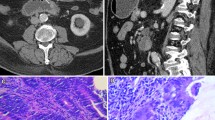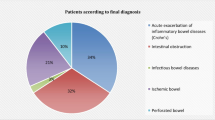Abstract
The aim of our study was to evaluate the reliability of MDCT-enteroclysis (MDCT-E), an emerging technique of small bowel examination that combines the advantages of MDCT examination of the abdomen and the enteral volume challenge of enteroclysis, in evaluation of small bowel neoplasms. In our institutions, MDCT-E was used to study 456 patients (age range 21–84 years, mean 53 years) admitted for suspicion of small bowel disease. All examinations were done on multichannel CT units, 129 on a 16-slice scanner and 327 on a four-slice scanner. Post-processing and multiplanar reformatting and interpretation were performed on dedicated workstations. After adequate gastrointestinal preparation and naso-enteric intubation, small bowel was distended by methylcellulose infused by a peristaltic pump. One volumetric MDCT acquisition was obtained after 120–130 ml of intravenous contrast medium. Multiplanar reformatting was based on the image reconstruction parameters from 3 to 4 mm. Forty-five small bowel neoplasms were found; in the remaining cases, 223 Crohn’s diseases and 149 other abnormalities were detected. All findings were confirmed by surgery, endoscopy or clinical follow-up. In our experience, MDCT-E with neutral enteral and IV contrast seems to be a reliable method in the diagnosis of small bowel neoplasms.










Similar content being viewed by others
References
Gourtsoyannis N, Makò E (1997) Imaging of primary small intestinal tumors by enteroclysis and CT with pathological correlations. Eur Radiol 7:625–642
Good CA (1963) Tumors of the small intestine. Am J Roentgenol 89:685–705
Maglinte DDT, Herlinger H (1999) Small bowel neoplasms In: Herlinger H, Maglinte DDT, Birnbaum BA (eds) Clinical imaging of the small intestine. Springer, Berlin Heidelberg New York, pp 377–438
Maglinte DDT, O’Connor K, Bessette J, Chernish SM, Kelvin FM (1991) The role of the physician in the late diagnosis of primary malignant tumors of the small intestine. Am J Gastroenterol 86:304–308
Zollinger RM Jr (1986) Primary neoplasms of the small intestine. Am J Surg 151:654–658
Yang YS, Huang QY, Wang WF, Sun G, Peng LH (2003) Primary jejunoileal neoplasmas: a review of 60 cases. World J Gastroenterol 9(4):862–864
Bessette JR, Maglinte DDT, Kelvin FM, Gernish SM (1989) Primary malignant tumors in the small bowel: a comparison of the small bowel enema and conventional follow-through examination. Am J Roentgenol 153:741–744
Gourtsoyannis N, Bays D, Malamas M, Barouxis G, Liasis N (1992) Radiological appearances of small intestinal leiomyomas. Clin Radiol 45:94–103
Horton KM, Fishman EK (2004) Multidetector-row computed tomography and 3-dimensional computed tomography imaging of small bowel neoplasms: current concept in diagnosis. J Comput Assist Tomogr 28(1):106–116
Horton KM, Fishman EK (2003). The current status of multidetector row CT and three-dimensional imaging of the small bowel. Radiol Clin N Am 41(2):199–212
Orjollet-Lecoanet C, Ménard Y, Martins A, Crombé- Ternamian A, Cotton F, Valette PJ (2000) L’entéroscanner: une nouvelle méthode d’exploration du grele. J Radiol 81:618–627
Voderholzer WA, Ortner N, Rogalla P, Beinholzl J, Lochs H (2003) Diagnostic yield of wireless capsule enteroscopy in comparison with computed tomography enteroclysis. Endoscopy 35(12):1009–1014
Bender GN, Maglinte DDT, Von Kloppel R, Timmons JH (1999) CT enteroclysis: a superfluous diagnostic procedure or valuable when investigating small-bowel disease? Am J Roentgenol 172:373–378
Grassi R, Di Mizio R, Romano S, Cappabianca S, Del Vecchio W, Severini S (2000) Multiple jejeunal angiodysplasia detected by enema-helical CT. Clin Imag 24(2):61–63
Rollandi GA, Curone PF, Biscaldi E, Nardi F, Bonifacino E, Conzi R, Derchi LE (1999) Spiral CT of the abdomen after distention of small bowel loops with transparent enema in patients with Crohn’s disease. Abdom Imaging 24(6):544–549
Rollandi GA, Biscaldi E (2000) CT enteroclysis. In: Terrier F, Grosholtz, Becker CD (eds) Spiral CT of the abdomen. Springer, Berlin Heidelberg New York, pp 369–383
Maglinte DDT, Bender GN, Heitcamp DE, Lappas JK, Kelvin FM (2003) Multidetector-row helical CT enteroclysis. Radiol Clin N Am 41(2):249–262
Bruel JM, Gallix B (2003) Multidetector CT and MR in diseases of the gastrointestinal tract. J Radiol 84:499–513
Schmidt S, Lepori D, Mewly JY, Duvoisin B, Meuli R, Michetti P et al (2003) Prospective comparison of MR enteroclysis with multidetector spiral-CT enteroclysis: interobserver agreement and sensitivity by means of “sign-by-sign” correlation. Eur Radiol 13:1303–1311
Boudiaf M, Jaff A, Soyer P, Bouhnik Y, Hamzi L, Rymer R (2004) Small bowel disease: prospective evaluation of multi-detector row helical CT enteroclysis in 107 consecutive patients. Radiology 233:338–344
Fleishmann D (2003) Future prospects in MDCT imaging. Eur Radiol 13:M127–M128
Verdun FR, Noel A, Meuli R, Pachoud M, Monnin P, Valley JF et al (2004) Influence of detector collimation on SNR in four different MDCT scanners using a reconstructed slice thickness of 5 mm. Eur Radiol 14:1866–1872
Author information
Authors and Affiliations
Corresponding author
Rights and permissions
About this article
Cite this article
Romano, S., De Lutio, E., Rollandi, G.A. et al. Multidetector computed tomography enteroclysis (MDCT-E) with neutral enteral and IV contrast enhancement in tumor detection. Eur Radiol 15, 1178–1183 (2005). https://doi.org/10.1007/s00330-005-2673-5
Received:
Revised:
Accepted:
Published:
Issue Date:
DOI: https://doi.org/10.1007/s00330-005-2673-5




